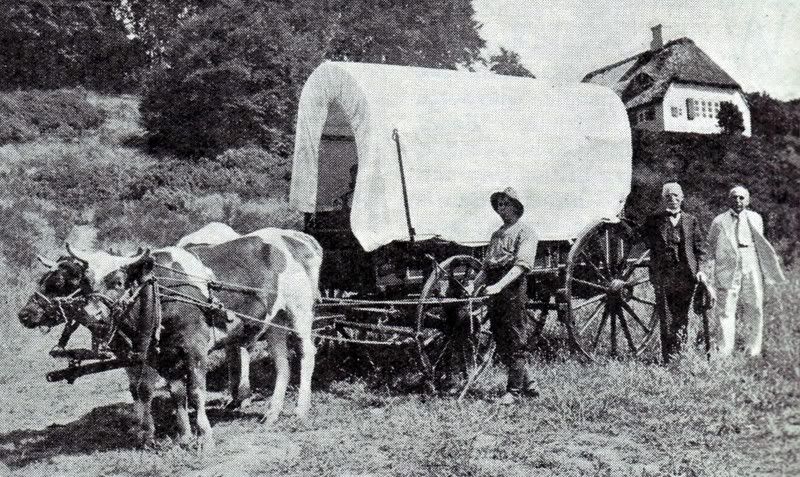“The century between 1814 and 1914 saw the largest migration in the history of mankind, with more than 50 million Europeans setting out for America and other overseas destinations” (Kristian Hvidt. Flight to America: The Social Background of 300,000 Emigrants. New York: Academic Press, 1975). The tiny kingdom of Denmark furnished a significant current in that tide of emigration.
Organized Mormon emigration from Denmark began in December 1852 when almost 300 Danes, shepherded by Elder John E. Forsgren, set out for Zion; traveling from Copenhagen to Liverpool to New Orleans, to Keokuk, Iowa, this company reached Salt Lake nearly ten months later, on September 30, 1853. It is the first known mass emigration from Denmark by any organization, Mormon or otherwise. Thousands more were to follow, making the Danes second only to the British as an immigrant group in Utah from 1860 through at least 1930.
A wave of non-Mormon emigration from Denmark to the U.S. began in the late 1860s, gathered momentum in the 1870s, and peaked in the mid-1880s, and far outpaced Danish Mormon emigration to Utah. By the turn of the century, first- and second-generation Danish-Americans were reversing course – many moved back to Denmark, and many more renewed their ties to Denmark by joining trans-Atlantic unity projects.
Perhaps the most successful of these trans-Atlantic organizations and projects was the construction of “Rebild Park” near Aalborg, a monument to the friendship between Denmark and the U.S., and the ties Danish-Americans have to Denmark. American Independence Day has been celebrated there since 1909 – it still is – and American icons, such as a log cabin tribute to Lincoln (with logs collected from each of the 48 states in the Union in 1934, when the cabin was built), have been placed there.
In 1935, the Rebild Park Association based in Chicago contacted Utah Governor Henry H. Blood about the possibility of obtaining a Mormon covered wagon to place in the Danish park, as a tribute to the Danish Mormon emigrants. The governor referred the project to the Daughters of Utah Pioneers. The DUP, with the assistance of the Salt Lake Chamber of Commerce and the Sons of Utah Pioneers, built a pioneer-style wagon using pieces of surviving original wagons, supplemented with new materials.
The wagon was ready to be shipped to Rebild Park in 1936, and the organizers of the project began looking around for a Danish-American to escort the wagon to Denmark and present it to the Danes. They settled on 84-year-old Andrew Jenson.
Jenson had emigrated from Denmark in 1866 when he was 15 – after scrambling to raise his own passage money when his emigrating parents told him they could not afford to take him, that he must remain behind until they could send him the money. While working as a farm hand, the teenager worked nights to translate the History of Joseph Smith into Danish, paid for its printing, and peddled its monthly installments for 10c a copy. As he traveled to sell his pamphlets, he collected stories regarding the early immigrants, and published them both in the Bikuben,, the Scandinavian newspaper he eventually edited and in the Morgenstjernen a monthly Danish magazine he published in the 1880s.
Jenson served two missions to Denmark, then returned as mission president from 1909-1912. He traveled to every corner of the world where Mormons could be found, interviewing, gathering data, and compiling the histories of each community. He published journal articles, and a handful of books, including a history of the Scandinavian Mission.
 And so in 1936, Andrew Jenson, accompanied by his wife and daughter and a few others, escorted the pioneer wagon on its eastward journey. In Chicago, the Rebild Association treated them to a banquet. In Copenhagen, the mayor greeted them. Oxen drew the wagon to the Park and Jenson formally presented it to the people of Denmark in honor of the Mormon emigrants from Denmark who had not forgotten their homeland. Before returning to Salt Lake, Jenson had a private audience with newly crowned King Christian, whose sister Ruth entertained the Jenson family in her home and at a formal party in the Embassy.
And so in 1936, Andrew Jenson, accompanied by his wife and daughter and a few others, escorted the pioneer wagon on its eastward journey. In Chicago, the Rebild Association treated them to a banquet. In Copenhagen, the mayor greeted them. Oxen drew the wagon to the Park and Jenson formally presented it to the people of Denmark in honor of the Mormon emigrants from Denmark who had not forgotten their homeland. Before returning to Salt Lake, Jenson had a private audience with newly crowned King Christian, whose sister Ruth entertained the Jenson family in her home and at a formal party in the Embassy.
It was Jenson’s last visit to his homeland, one that in so many ways reversed the trail he had traveled in 1866.
Continue reading at the original source →



